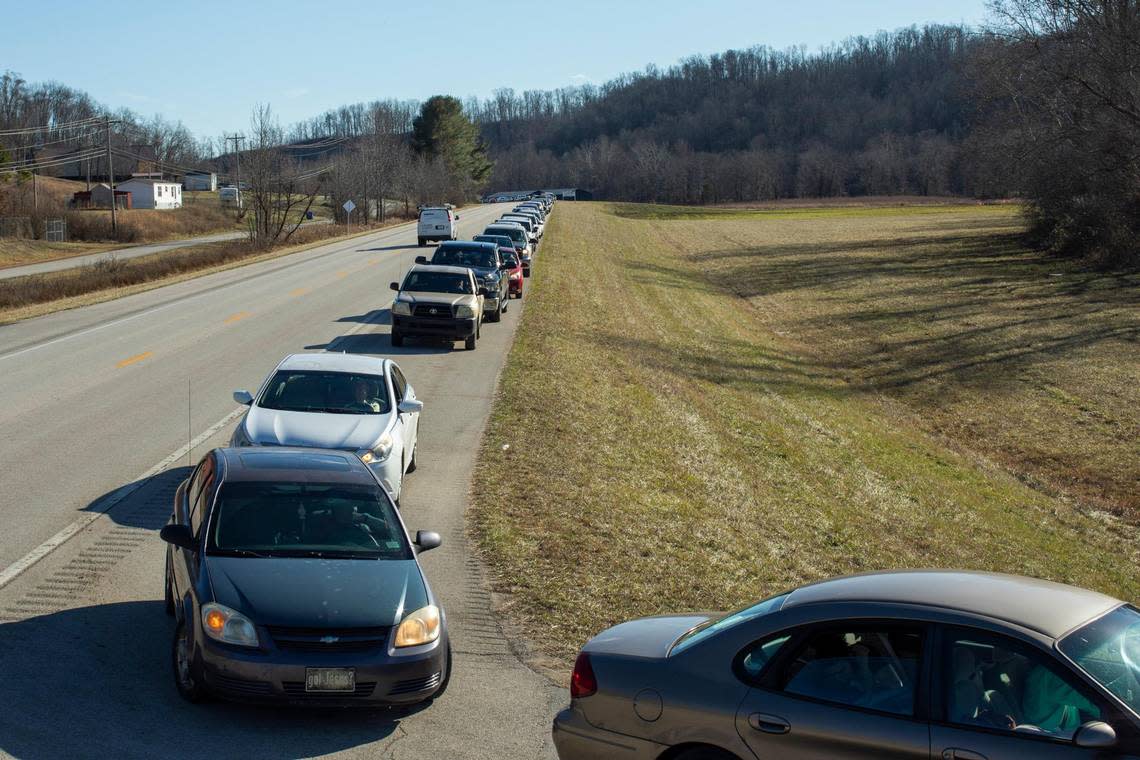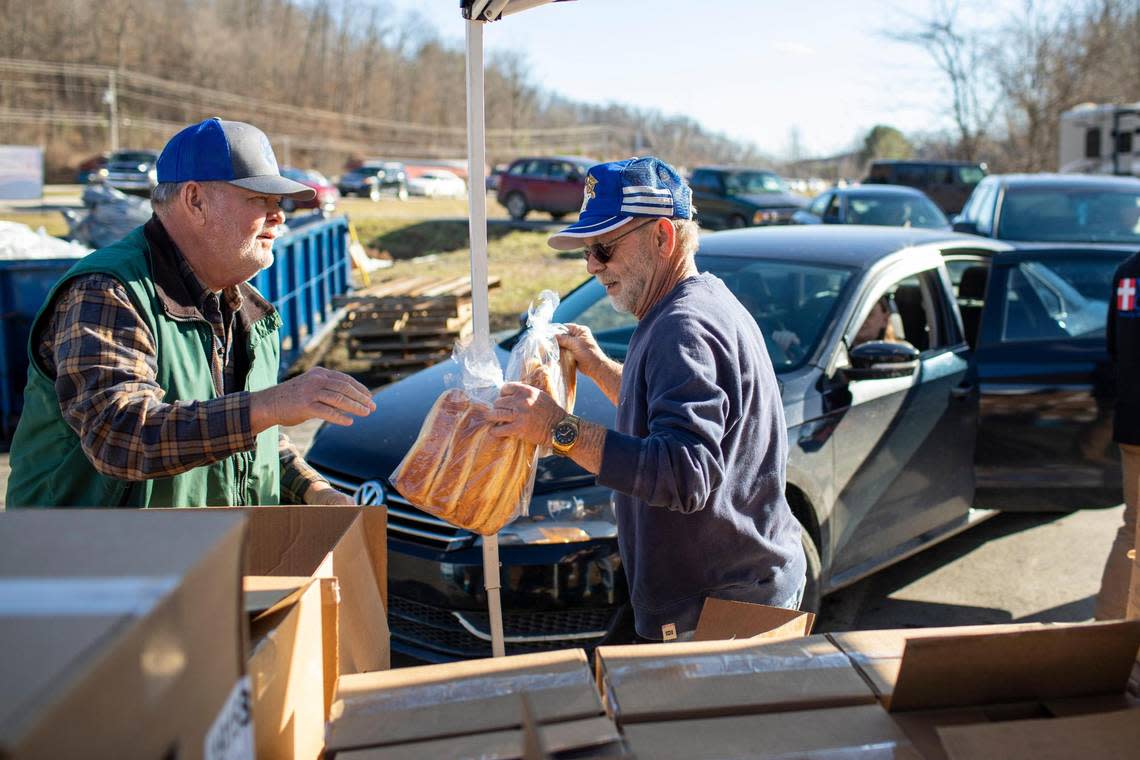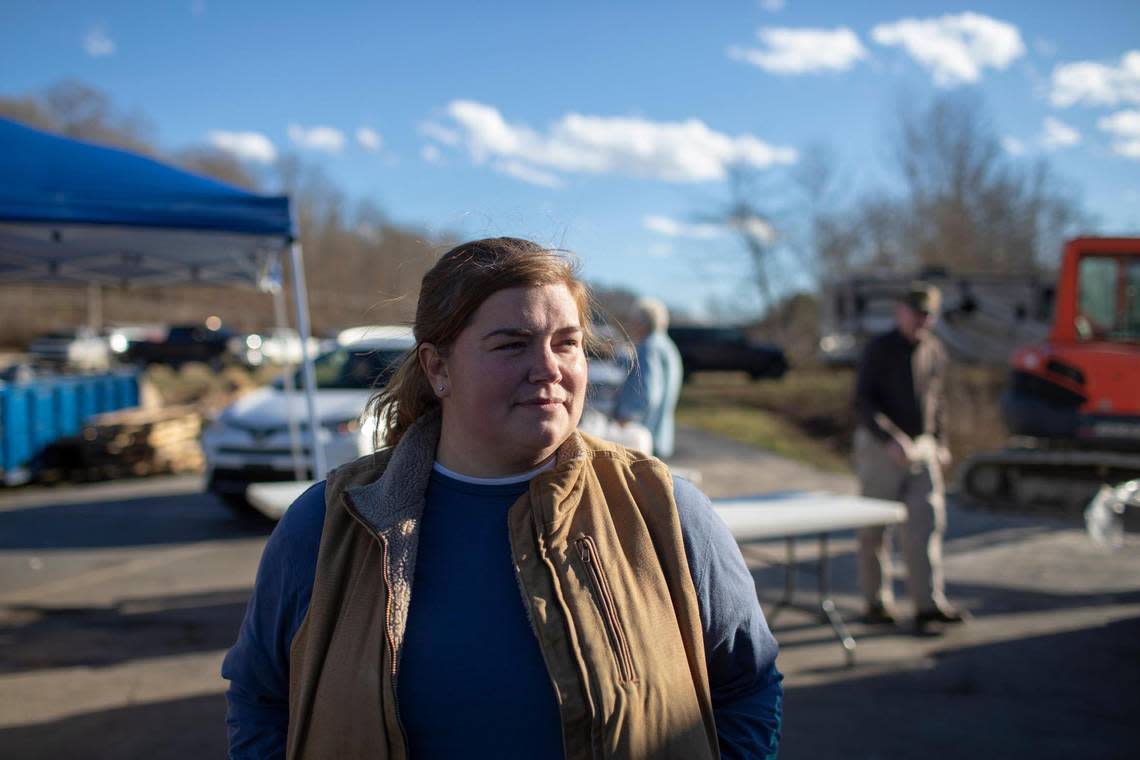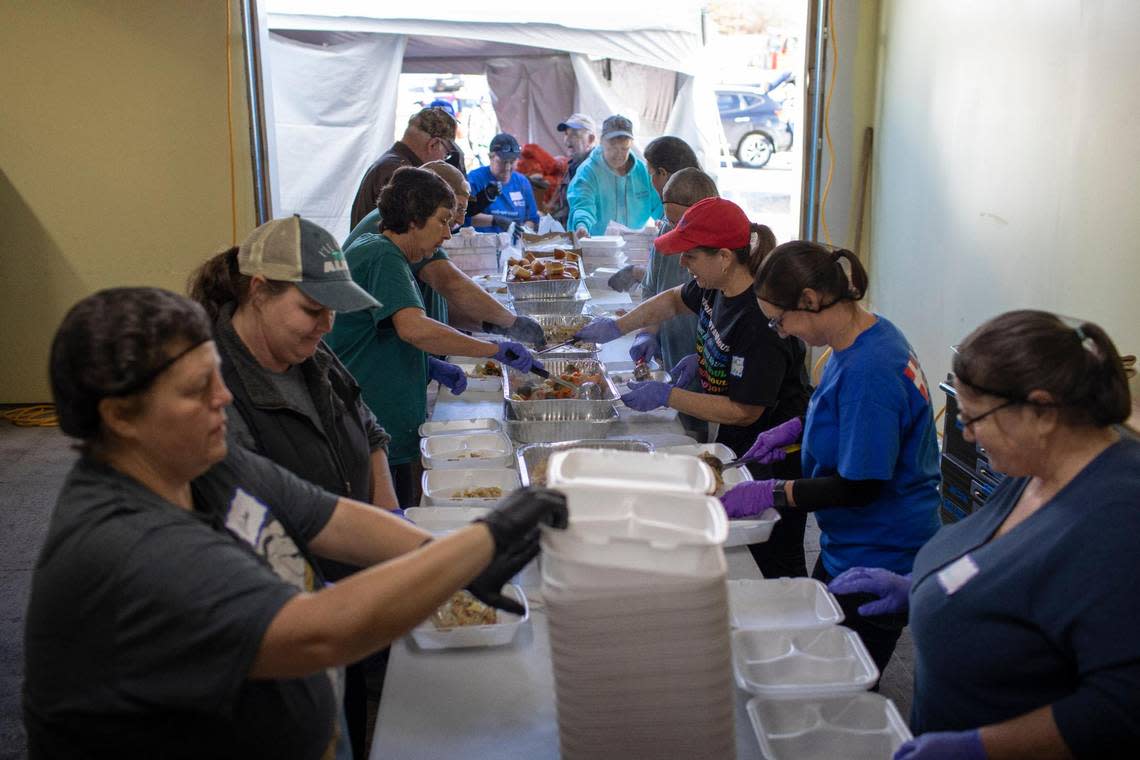Eastern Kentucky’s food crisis is on a ‘pendulum swing.’ What’s behind the deepening issue?
The line of cars waiting for food stretched out of sight, following the bends of the two-lane road and disappearing between tree-lined hills.
After a few hours of steady work by dozens of food-prepping volunteers, the end of the line was within squinting distance. For the Hazel Green Food Project, a food bank in eastern Wolfe County, this particular January day was a slow one, said Nicky Stacy, the project’s president.
Usually the food bank has twice monthly drive-through food giveaways. The food starts getting distributed at 1 p.m., but according to Stacy, the line starts much earlier and has previously backed up traffic on the Bert T. Combs Mountain Parkway — over a mile away.
“You have senior citizens who will be in their sleeping bags parked out here at four o’clock in the morning because they have to pick between medicine and groceries,” Stacy said.
The Hazel Green Food Project started nearly two years ago and is a relatively short drive to multiple surrounding counties. When the project began, Stacy said they were feeding close to 300 families, but demand has ballooned to nearly 3,000 across multiple counties.
Federal SNAP benefits, previously known as food stamps, expanded at the onset of the COVID-19 pandemic, giving those who participate in the program greater ability to buy more food. But when the state legislature passed a resolution last spring that ended the state’s public health emergency, Kentuckians saw many of those expanded benefits evaporate overnight.
“That’s when our line doubled,” Stacy said. “And then that’s when we were really struggling just to find food, just to make sure everybody got something.”
When compared with the rest of the state, multiple Eastern Kentucky counties sit near the top of the list in both food insecurity and SNAP participation. Researchers who study the region observed actual decreases in food insecurity during the height of the pandemic, but saw that quickly reverse.
The sudden cut off of expanded federal benefits — combined with rising food prices — is deepening a food access crisis in the region, multiple experts told the Herald-Leader.

Food insecurity by the numbers
Food security is a measure of how well a household might be able to afford and access nutritious foods. According to the USDA, a food insecure household may have trouble accessing food to the point where cheaper, less nutritious foods might be substituted to fill out a diet. In more dire cases, very low food security can result in simply eating less food.
Over 12% of Kentucky households experience food insecurity in some way, USDA data collected from 2019 to 2021 shows. That’s above the U.S. average of 10.4% during that same time frame.
Well over 700,000 people in Kentucky are food insecure, Ryan Quarles, the state’s agriculture commissioner told the Herald-Leader in an interview.
Multiple Eastern Kentucky counties had a food insecurity rate over 20% in 2020, according to data released by Feeding America, the country’s largest domestic hunger-relief organization. By that count, Wolfe County had the highest rate in the state at 25.9%, but multiple nearby counties had similar rates.
Food insecurity is tightly linked with poverty and those who experience both often have to make tough decisions on what to do with their limited funds. Some have to pick between essentials like medication and food, said Alison Gustafson, a University of Kentucky professor whose work has focused on improving food access in rural, underserved populations.

The pendulum swings
Gustafson and a team of UK researchers have been part of a long-running CDC program that studies obesity and food access in multiple counties. Martin County, sitting on Kentucky’s border with West Virginia, has been one of the study’s main locations for years.
Over the course of spring 2021, researchers interviewed 59 Martin County residents about how their access to food might’ve changed because of the COVID-19 pandemic and published their findings in the International Journal of Environmental Research and Public Health. Many interviewed residents reported an initial local shortage of food early in the pandemic followed by increased food-related aid locally and an emergency expansion of federal food assistance.
“I draw $16 a month before that, and now I get $200, and Lord has that helped me,” one participant told researchers about their SNAP monthly benefit amounts. “That’s put food in my deep freezer and on the shelves. And I eat good now!”
The expansion of SNAP benefits and federal stimulus checks helped some families reach a level of economic stability that they “had never experienced before,” said Kathryn Cardarelli, a UK faculty member in the College of Public Health and lead author on the study.
“Then of course that assistance ended, and now we’re seeing quite a wide swing of circumstances with all of the inflation and the cost of food and gas and utilities and everything rising,” Cardarelli said. “It’s really been a pendulum swing far in the other direction.”
The expanded SNAP assistance in Kentucky ceased when the state legislature passed Senate Joint Resolution 150 in the 2022 session, which ended the state’s public health emergency, said Jessica Klein, a policy associate at the Kentucky Center for Economic Policy.
During the health emergency, SNAP benefits were on average 41%, or over $100 per month, higher than normal, non-emergency rates, an analysis of Kentucky SNAP data done by the Kentucky Center for Economic Policy showed.
Meanwhile those expanded federal benefits continued in states that hadn’t ended their health emergencies. A recent analysis by the Kentucky Center for Economic Policy’s Dustin Pugel found that, by the end of February, the state will have missed out on $558 million in federal food assistance. At the end of this month, the expanded federal benefits will expire nationally, affecting states that haven’t already declared an end to the health emergency.
“So that doesn’t impact us but other states are now going to be kind of facing what we’ve been facing for the past 10 months,” said Klein, who also heads the Kentucky Food Action Network.
In other states, hunger experts are ringing alarm bells for what the end of SNAP emergency allotments could mean for rural communities nationally, The Daily Yonder reported last week. SNAP participation is higher in rural areas and previous USDA research has shown that SNAP dollars contribute disproportionately more to rural economies.

At the Hazel Green Food Project, Stacy said people would come through the line crying, apologizing for being there.
“There are so many people in that line right now that draws $15 or under in food stamps (per month),” Stacy said. “And those are the grandmas who’re raising grandchildren.”
A family of four that might’ve had half their grocery bill covered by SNAP during the health emergency are now only seeing SNAP cover a quarter of it, Gustafson said. With food prices increasing anywhere from 12-30%, depending on the item, families are forced to buy less.
“We’ve seen an increase, especially in our eastern counties, with families reporting food insufficiency, meaning they don’t have enough healthy items, but also then food insecurity,” Gustafson said. “So they are going without, and they’re skipping meals, and their kids are skipping meals.”
Food pantries in Hazard in Perry County and another in Floyd County told UK researchers they’d seen their demand double as well, Gustafson said. Those food banks also saw a decrease in donations, likely brought on by an increase in the price of food.
What’s being done?
Researchers have also documented a “really strong value of taking care of one another” in communities throughout Appalachian Kentucky, Cardarelli said, noting that multiple churches and pop-up food pantries have stepped up in times of financial distress.
That much was evident at Hazel Green in January. Mercy Chefs, a Virginia-based food relief organization that provides hot meals to disaster areas all over the world, took up residence at the Hazel Green Food Project for nearly a month, serving over 85,000 hot meals and giving away 90,000 pounds of protein.
“We’re usually feeding men, women and children in times of desperation when it comes to a disaster,” said Molly MacDonald, a lead volunteer coordinator for Mercy Chefs. “But in this case, what we get to do is do more of a humanitarian response and we get to touch not only this county of Wolfe County, but 10 other counties.”
Volunteers from multiple surrounding counties came to assist. The food bank is strategically situated so that it’s less than a half hour’s drive to several county seats. Magoffin County High School football players were helping to prep and run food. Multiple church vans were scooping up arm loads of donations to be taken back and provided in their home counties. Menifee County Superintendent Tim Spencer said they were taking 800 meals daily back to Frenchburg to be distributed at five churches.
After he got food from the project, Kernie Roark told the Herald-Leader he’d driven daily from neighboring Magoffin County to get Mercy Chefs meals and food from Hazel Green. At one time, he’d arrived at the project at 7 a.m. to find “five or six cars” already in line.
“I’m a senior citizen doing without food,” Roark said before adding his thanks to the food pantry for “feeding thousands of hungry people daily.”

The Food is Health Alliance, which is headed by Gustafson, is looking to test a couple of food insecurity pilot programs. One would provide vouchers for vegetables for those with certain health conditions. Another program would deliver meal boxes containing enough food to cover five lunches and five dinners “to help supplement people’s food bill,” Gustafson said.
Gustafson said pilot testing for the programs are slated to start this summer in Allen County in southern Kentucky, in Hazard via Appalachian Regional Healthcare and in Lexington and Louisville through UK Healthcare.
The Kentucky Hunger Initiative was started by the state Department of Agriculture in 2016 in an effort to help the state’s anti-hunger groups coordinate with food producers, said Commissioner Quarles, who is also running for the Republican gubernatorial nomination.
At the national policy level, this year is also the deadline to pass a new Farm Bill, the legislation that authorizes SNAP. Klein said they’re hoping the bill is passed with additional support for SNAP.
Quarles said he plans to be “very active” in discussions around the next Farm Bill. He submitted written testimony to a U.S. Senate committee meeting on food insecurity. He also visited Hazel Green during food distribution, calling it “another stark reminder about how big the need is particularly in Eastern Kentucky for people of all ages.”
At Hazel Green, Stacy said she’s been trying to raise awareness among those in Frankfort of the food crisis in Eastern Kentucky “for so long.”
“We’ve just been screaming from the rooftops that there’s something that needs to be done here in Eastern Kentucky and no one listens,” Stacy said. “And that’s why we are serving, we have served 27 counties out of the whole state of Kentucky so far. I mean, we’re just going to continue to grow.”






